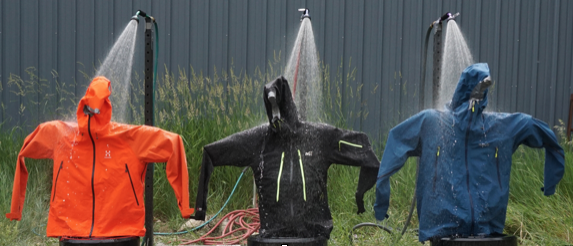
Testing the breathability of fabrics on the treadmill.
This Mini-Study was first published in Sommer 2016
By Kyle Bochanski and Liza Sarychev
In March, MTI completed a study that compared the breathability of five rain coats. Three used Gore-tex fabric ($200 to $600), one used NanoPro ($100) and another used PVC ($15). We came to two practical conclusions.
- Breathable jackets are up to 500% more breathable than non-breathable jackets.
- The NanoPro fabric was the best deal in terms of breathability and cost.
The study can be found at: http://mtntactical.com/all-articles/study-results-gore-tex-worth-cost/.
In the outdoor setting, the other contributing factor to protection against the elements is water resistance. A rain jacket has to be able to both breath well and resist rain water to keep you dry. For this week’s mini-study, we decided to take a look at this additional factor in gear efficacy and compared both the breathability and water resistance of three different rain-jacket materials.
Mini-Study Design
We compared three fabrics for breathability and water resistance:
Fabric Jacket
Neoshell Millet Freerando Neo Jacket –
Gore-Tex Pro Shell Haglöfs Roc Spirit Jacket
eVent: Rab Latok Alpine Jacket
To test breathability, we took one subject and had them walk at 2 mph at a 10% grade with 30 lbs on a treadmill for 60 minutes, testing each jacket. The subject maintained a constant heart rate of 125 bpm. We compared saturation rates of the base layer to determine which fabric type has the best breathability.
The graph below shows rates of base layer saturation. The top line shows that every minute, the base layer under the eVent shell acquired about 6.5 grams of sweat, while the Neoshell and Gore-tex Pro fabric accumulate about 4 grams of sweat.
Practically, this means Gore-tex and Neoshell fabrics had similar breathability and better breathability than the eVent because the base layer under these two jackets accumulated less sweat per minute.

Notice how the base layer with no shell has a sweat accumulation of about 3.3 grams of sweat per minute of activity. This means that the eVent and Gore-tex/Neoshell fabric withhold 3.2 grams and 0.7 grams of water per minute respectively.
In an hour this would equate to a half soda can of sweat from the eVent jacket and a sixth of a can for the Gore-Tex and Neoshell jacket.
Initially this seems indicative of breathability differences. The eVent jacket, however, was tested last and the temperature had risen 4 degrees Fahrenheit (70 to 74 degrees and 36% to 40% humidity) which could have played a role in sweat accumulation rates and breathability of the jacket.
This means that at best, we know Neoshell and Gore-tex most likely breathe equally well, and could breathe better than eVent.
Jacket “Wet Out” Study
“Wet Out” of waterproof breathable fabrics occurs when water saturates the jackets outer fabric layer above the waterproof/breathable layer, leaving the wearer feeling damp and clammy – as if the jacket were leaking – even if it’s not.
To prevent “wet out” waterproof breathable jackets and other clothes are treated with an ultra-thin “durable water repellent” (DWR) polymer. DWR penetrates the outer fabric fibers, lowering the surface tension of the fabric. This causes water to bead up and roll off instead of being absorbed.
However, DWR is not permanent. Regular wear, dirt, etc. shorten its lifespan. Once worn out, it can be reactivated by washing and drying the jacket. After the factory-applied DWR can no longer be reactivated, new DWR can be applied using a pump spray or wash in product. Nikwax TX-direct wash in is one product example.
To test jacket “wet out”, we set up the three jackets under equal pressure shower heads to observe overall water resistance and when/if the jackets would “wet out.”
Shower velocity for each shower head was equal, and measured at 992 cubic inches per minute – far greater than any naturally occurring rainfall.
As you see in the photo, the jackets were each set up in a scarecrow form. Under each jacket was a synthetic base layer. We weighed the base layers for wetness at 15 minute intervals. Specifically, every 15 minutes, we turned off the showers, removed the jackets, and weighed the base layers underneath.
We ran the test for 4 hours, and all the base layers stayed within 0.1 oz of their original weight over the 4 hours under the shower heads.
Practical Implications
Each of the jackets tested was relatively new – none had been worn in the field, and the only work the jackets had completed prior to the “wet out” test was our breathability study above.

“Scarecrowed” jackets during out wet out test.
Thus, the degradable durable water resistance (DWR) for each jacket was new, and this likely helped keep the jackets’ performance in our wet out test – even under 4 hours of heavy water treatment.
Next Steps
Breathability – Gore-Tex fabrics dominate the market, and we’d hope this pilot study would help compare to the major competing fabrics of Neoshell and eVent. We did find a difference in performance, but the increase in room temperature and humidity for the eVent jacket test may have skewed our results. We’ll need to re-do the test and find a way to better control our environment.
Wet-Out – We’re not sure how to proceed here. What we did learn for sure from the 4-hour study is the factory-applied DWR of each jacket is effective under the test conditions.
But we’re not so interested in testing DWR as we are fabric differences. Somehow we’re going to need to test jackets with equal wear or with no factory-applied DWR.
Again, not sure how to proceed.
Questions? Email coach@mtntactical.com
Comments? Please enter your comment below.
